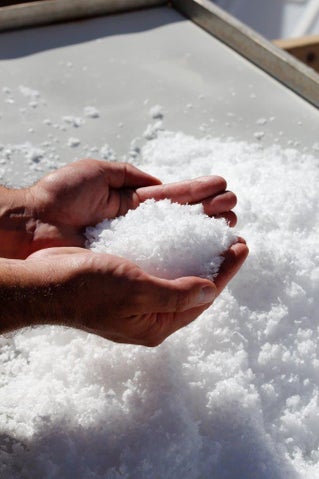A Grain of Salt
Salt seasons and preserves our food, but too much will ruin it. In recent years salt has gone from hum-drum finely milled table salt to flakes of finesse, so, what’s the difference?
There are three basic methods of salt production each used from ancient times.

1) Rock salt is mined in blocks and pulverised.
This salt is used for gritting iced roads, but its coarse texture has given rise to the name of any very coarse salt we use on the table or in the kitchen. This may or may not come from underground sources today. Hence the confusion with rock salt’s origins.
 2) A brine solution is made from rock salt or salt water, taken from springs or the sea and dehydrated in vacuum-sealed or open pans. eg. Maldon Salt from Britain.
2) A brine solution is made from rock salt or salt water, taken from springs or the sea and dehydrated in vacuum-sealed or open pans. eg. Maldon Salt from Britain.
Maldon salt takes only 7 days to make, but its location and climate are an important part in its process. The low-lying marshlands around the Essex coast are covered in water at high tide, which then evaporates to leave salty deposits in the soil and vegetation. When the tide comes up again some salt is reabsorbed, resulting in rather briny water. The water is drawn in from the sea, filtered to remove sand and rubbish and placed into pans and simmered, until it can be raked, left to drain in snowy piles until ready for packaging.
3) Sea water is evaporated by means of a system of basins and salt pans. Brands include New Zealand’s Pacific Salt from Marlborough, Iblea Sea Salt from Italy, Sel Marin from France.
On a regular basis water is let in from the sea to natural pans. As the water evaporates it is transferred to the next pan down the chain and this continues for many months up to and sometimes beyond 12 months, until the water becomes very briny. The crystals that are formed are dug or chipped out and ground to the mill required. For the finest in this category look for salts labeled Fleur de Sel or Flower of Salts. These are made by hand harvesting the salt flakes that form on top of the water basins.
Ecologically the third is the one most preferred as it uses the sun and wind. However it is the most costly in terms of time and manpower. The mineral content of the water used, which will vary greatly from one end of the earth to the other, will dramatically influence the colour, taste and crystal structure of the salt produced.
While it is lovely to use flaky sea salts it is a wise idea to have a pot of plain milled salt in the kitchen to add to the boiling pot of pasta or potatoes, as here you are unlikely to taste the difference between the most expensive and the cheapest.
Use expensive salts where you can appreciate their flavour - sprinkled on breads, beside radishes for dipping, with radishes, on a salad, sprinkled on food before eating etc.

Salt Variants:
Free-flowing Iodised Salt
Is salt that has iodine added to reduce goitre and possible dementia and the percentage is minute. The free flowing agent is Silicon dioxide (551). This salt seems harsher and saltier, but when you try it, consider its fine mill, which gives it greater surface area and therefore more salt taste. Use it for cooking. Do not use for pickling.
Smoked Salt
Salt that has been smoked over wood fires to add a new dimension and flavour. Delicious sprinkled over a roast chicken before baking.
Flavoured Salts
Flaky, fine mill or coarse ground salts blended with herbs and spices to add flavour to cooking.
Kosher Salt
Is prepared for cooking according to Jewish dietary guidelines.
Black Salt
Is an unrefined salt that is actually a musty pink in colour. It has a powerful sulphuric smell and is used in authentic Indian cooking. See an Indian food shop for product.


Comments (0)
Please login to submit a comment.